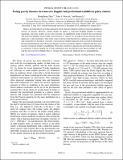Files in this item
Testing gravity theories via transverse doppler and gravitational redshifts in galaxy clusters
Item metadata
| dc.contributor.author | Zhao, Hongsheng | |
| dc.contributor.author | Peacock, John | |
| dc.contributor.author | Li, Baojiu | |
| dc.date.accessioned | 2014-08-13T16:01:00Z | |
| dc.date.available | 2014-08-13T16:01:00Z | |
| dc.date.issued | 2013-08-26 | |
| dc.identifier | 70762932 | |
| dc.identifier | 664eba40-7c78-4fd3-b953-a79c748e6931 | |
| dc.identifier | 84884850484 | |
| dc.identifier.citation | Zhao , H , Peacock , J & Li , B 2013 , ' Testing gravity theories via transverse doppler and gravitational redshifts in galaxy clusters ' , Physical review. D, Particles, fields, gravitation, and cosmology , vol. 88 , no. 4 , 043013 . https://doi.org/10.1103/PhysRevD.88.043013 | en |
| dc.identifier.issn | 1550-7998 | |
| dc.identifier.other | ArXiv: http://arxiv.org/abs/1206.5032v2 | |
| dc.identifier.uri | https://hdl.handle.net/10023/5143 | |
| dc.description.abstract | There is growing interest in testing alternative gravity theories using the subtle gravitational redshifts in clusters of galaxies. However, current models all neglect a transverse Doppler redshift of similar magnitude, and some models are not self-consistent. An equilibrium model would fix the gravitational and transverse Doppler velocity shifts to be about 6σ2/c and 3σ2/2c in order to fit the observed velocity dispersion σ self-consistently. This result comes from the Virial Theorem for a spherical isotropic cluster, and is insensitive to the theory of gravity. A gravitational redshift signal also does not directly distinguish between the Einsteinian and ƒ(R) gravity theories, because each theory requires different dark halo mass function to keep the clusters in equilibrium. When this constraint is imposed, the gravitational redshift has no sensitivity to theory. Indeed our N-body simulations show that the halo mass function differs in ƒ(R), and that the transverse Doppler effect is stronger than analytically predicted due to non-equilibrium. | |
| dc.format.extent | 4 | |
| dc.format.extent | 177040 | |
| dc.language.iso | eng | |
| dc.relation.ispartof | Physical review. D, Particles, fields, gravitation, and cosmology | en |
| dc.subject | astro-ph.CO | en |
| dc.subject | astro-ph.GA | en |
| dc.subject | gr-qc | en |
| dc.subject | QB Astronomy | en |
| dc.subject.lcc | QB | en |
| dc.title | Testing gravity theories via transverse doppler and gravitational redshifts in galaxy clusters | en |
| dc.type | Journal article | en |
| dc.contributor.sponsor | Science & Technology Facilities Council | en |
| dc.contributor.institution | University of St Andrews. School of Physics and Astronomy | en |
| dc.identifier.doi | 10.1103/PhysRevD.88.043013 | |
| dc.description.status | Peer reviewed | en |
| dc.identifier.grantnumber | ST/J001651/1 | en |
This item appears in the following Collection(s)
Items in the St Andrews Research Repository are protected by copyright, with all rights reserved, unless otherwise indicated.

